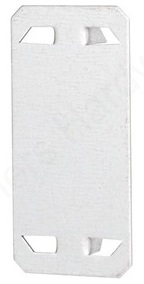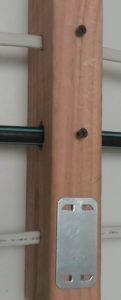 Though Cable Protector Plates (sometimes called Nail Stops) are a physical penetration prevention required by building code in other countries, they are virtually unheard of in NZ even though they are specified in certain conditions by the NZ Standards. If you walk into a Bunnings or Mitre 10 and ask for these, you are guaranteed to get puzzled looks and vague recommendations on other stores that may carry them. Part of this has to do with a lack of previous New Zealand experience. Another part may involve a lack of responsibility and liability. Both of these are illustrated below from personal experiences within our company.
Though Cable Protector Plates (sometimes called Nail Stops) are a physical penetration prevention required by building code in other countries, they are virtually unheard of in NZ even though they are specified in certain conditions by the NZ Standards. If you walk into a Bunnings or Mitre 10 and ask for these, you are guaranteed to get puzzled looks and vague recommendations on other stores that may carry them. Part of this has to do with a lack of previous New Zealand experience. Another part may involve a lack of responsibility and liability. Both of these are illustrated below from personal experiences within our company.

Situation 1:
We talked with a builder in Hamilton about Cable Protection Plates. He was willing to try them in the kitchen of a home that he was building in Rototuna. He trialed them in the kitchen because cabinet screws are longer than GIB screws and reach further into the studs where water and electrical pipes are housed. He installed them and the chippie arrived the next day to install the GIB. The very day, the chippie hit a Cable Protection Plate and told the builder. This builder knew how much money and time was saved by spending $25 in Cable Protection Plates that he has vowed to use them on every build he does from then on.
Situation 2:
We were talking with plumbers to determine if Cable Protection Plates would be something that they could use to add value to their work. We suggested that this was a way to provide a better quality end product with added safety and security to the home owner. One discussion with a plumber wrapped up with the short paraphrased summary below:
ThermaScreen: (to plumber) ‘You have admitted that these Cable Protection Plates offer an inexpensive advantage for the home owner and can add security and safety to your delivered product. Would you be interested in trialing some in you next job?’
Plumber: ‘I don’t think so. Let me put it this way… We do mainly residential building here. Each year, we get about 15 of these calls where someone has screwed through a pipe and we have to come out and repair them. On each one of these calls, we get to on-charge probably $10k in materials, labour, and call outs. You are suggesting that I spend $400 to remove $150,000 of my income? It just doesn’t make sense.’
ThermaScreen: ‘I understand where you are coming from, but by not diverting labour to fixing those jobs, you will free up your workers to complete your existing jobs faster so you can book more jobs. You will still be earning money but you will also be providing safety to your customers.’
Plumber: ‘Their safety is not my concern.’
ThermaScreen: (rather surprised by the direct response) ‘What happens if a gas line is hit and causes a fire or if the house explodes?’
Plumber: ‘It is not my house and I don’t live there.’
This was one extreme comment in a number of discussions with plumbers. In general, a majority of the discussions were more polite, but had one recurring theme: If it is not required to meet minimum code, they don’t want to spend money for added safety that isn’t required yet. They don’t pay for the repair when someone hits one of their pipes, that expense gets passed to the builder. They will provide Cable Protection Plates when they are requested by either the customer, or when minimum code changes.
In summary
Kiwi consumers don’t have the experience to know what they are missing concerning Cable Protection Plates. On the manufacturing side, many are only interested in meeting minimum code requirements. Unless that mentality and experience changes, the minimum code changes, or builders/customers specifically request Cable Protection Plates; the builders and homeowners will continue to bear the added cost for repairs and delays from punctured pipes and cables.

So can I get these in NZ? I have electrical cable running through 70mm stud walls. The NEW ZEALAND ELECTRICAL CODE OF PRACTICE FOR HOMEOWNER/OCCUPIER’S ELECTRICAL WIRING WORK IN DOMESTIC INSTALLATIONS says “All cables must be at least 50 mm from the finished surface of the wall, etc, that covers the cabling; for cables with less than 50 mm cover, mechanical protection will be required”. Thus even in a 90mm stud wall with 10mm gib you exceed the 50mm.
You can get these in NZ. We have these in stock and can ship them throughout the country when you need them. Just let us know how many you need and we can supply them.
How do we get hold of nail stops and how much do they cost?
Dave,
Thank you for your inquiry. To contact us, simply reach out to us through our Contact page via this website. Since you have provided your email address with this request, I have also emailed you privately concerning the most recent pricing and shipping options. We thank you for your enquiry and look forward to hearing from you again.